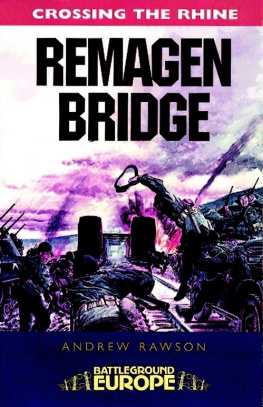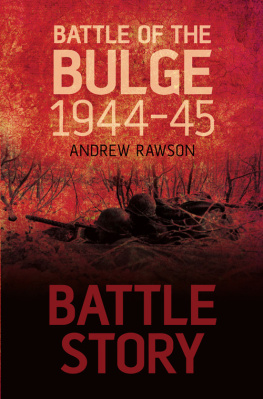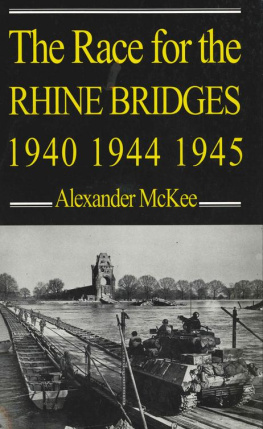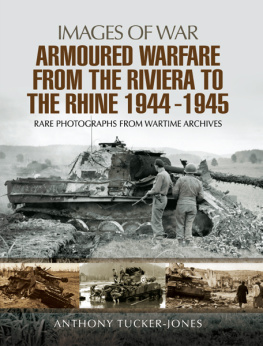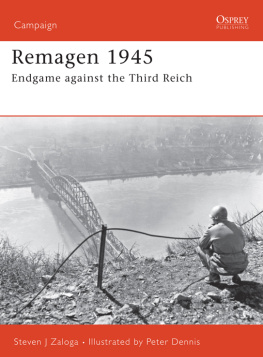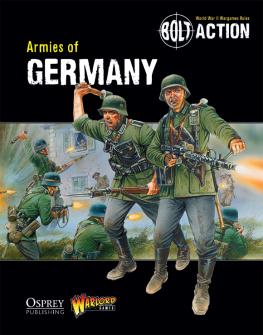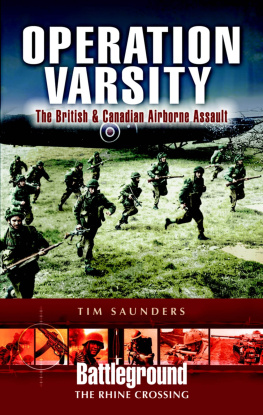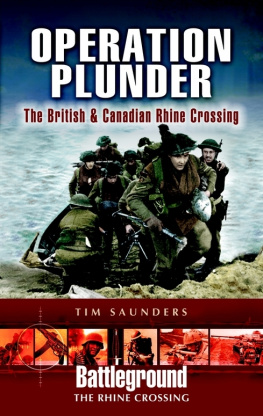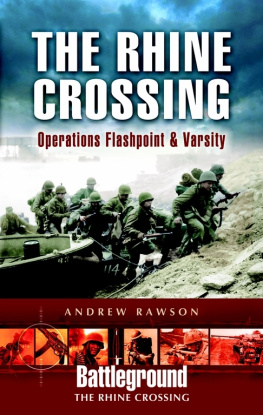Andrew Rawson - Remagen Bridge 9th Armoured Infantry Division
Here you can read online Andrew Rawson - Remagen Bridge 9th Armoured Infantry Division full text of the book (entire story) in english for free. Download pdf and epub, get meaning, cover and reviews about this ebook. year: 2004, publisher: Pen and Sword, genre: Science fiction. Description of the work, (preface) as well as reviews are available. Best literature library LitArk.com created for fans of good reading and offers a wide selection of genres:
Romance novel
Science fiction
Adventure
Detective
Science
History
Home and family
Prose
Art
Politics
Computer
Non-fiction
Religion
Business
Children
Humor
Choose a favorite category and find really read worthwhile books. Enjoy immersion in the world of imagination, feel the emotions of the characters or learn something new for yourself, make an fascinating discovery.
- Book:Remagen Bridge 9th Armoured Infantry Division
- Author:
- Publisher:Pen and Sword
- Genre:
- Year:2004
- Rating:4 / 5
- Favourites:Add to favourites
- Your mark:
- 80
- 1
- 2
- 3
- 4
- 5
Remagen Bridge 9th Armoured Infantry Division: summary, description and annotation
We offer to read an annotation, description, summary or preface (depends on what the author of the book "Remagen Bridge 9th Armoured Infantry Division" wrote himself). If you haven't found the necessary information about the book — write in the comments, we will try to find it.
Remagen Bridge 9th Armoured Infantry Division — read online for free the complete book (whole text) full work
Below is the text of the book, divided by pages. System saving the place of the last page read, allows you to conveniently read the book "Remagen Bridge 9th Armoured Infantry Division" online for free, without having to search again every time where you left off. Put a bookmark, and you can go to the page where you finished reading at any time.
Font size:
Interval:
Bookmark:
The capture of the Ludendorff Bridge at Remagen in March 1945 was one of those unplanned events in history, the consequences of which far outweigh the effort expended. Casualties were a fraction of other important engagements, and the number of men involved in the initial crossing only amounted to a few dozen. Yet the news that an intact bridge over the Rhine had been captured rocked the Western World. In America the event was considered to be so important that the meeting in progress at the US Senate was halted to announce the news. Many books have been written about the crossing of the bridge, and in 1969 Wolper Pictures Limited produced an action packed film based on the events at Remagen. This book is not about Hollywood, it is an attempt to describe the events leading up to the capture of the bridge and the fierce fighting that followed on the east bank of the Rhine, an aspect that has been overlooked in previous accounts. Crossing the bridge at Remagen was only the start of the battle and many GIs memories of Rhineland focus on the battle for the Westerwald. Hopefully, the balance is right.
A number of people have helped me write this book, and my research would have been incomplete without their assistance. All the staff at the US National Archives in Washington DC, made me feel extremely welcome and helped to make my visit to the USA both fruitful and memorable. There are, however, a handful of people who took me under their wing and deserve a special mention. In particular I would like to thank David Giodarno, who initially gave me a guided tour through the printed documents archives and continued to keep an eye on my progress, giving useful tips as the days passed; his assistance was invaluable. Beth Lipfords ongoing guidance as I worked through the indexing system to order documents meant that I received the material I wanted in good time. Meanwhile, Tom McAnear worked hard to locate and copy the maps I required in the cartography room. Holly Reed in the photographic department also made sure that I obtained the photographs I needed. As my departure date drew near, everyone worked hard to make sure that I collected the material I required; customer service is certainly uppermost in the minds of the staff at the NARA.
Kurt Kleemann, curator of the Brcke von Remagen (Bridge at Remagen) museum has been particularly helpful. During our long meeting at his office, I was able to discuss many of the myths that surround the capture of the bridge. A second opinion from someone who has studied the events at Remagen for years proved invaluable, dispelling a number of doubts I had concerning the events on 7 March 1945. I would also like to thank Herr Kleemann for giving me permission to use a number of photographs from the museums collection, depicting German subjects. They have helped to give the book the balance I wanted.

Following the capture of the bridge the Germans attempted to bring it down by various means here an artillery shell explodes in the Rhine.
Although I never knew them and probably never shall, I will always have a high regard for the men who kept the Army records in March 1945. Their unit diaries, signal records, after-action reports and interviews have formed the basis for my research. The records were put together under difficult circumstances and one particular report, the signal records for the 14th Tank Battalion, brought it home to me that these reports were taken in real time. Line after line of messages fill the pages, each one timed and referenced; an invaluable aid to the historian wishing to track the events as they unfold. Yet the thing that struck me was that the handwriting was shaky; this man was on the move as he made his notes, sat at the side of his officer as their Jeep drives towards Remagen. Only on this day he will record the capture of a bridge that will be front page news across the world and later be described by Eisenhower as worth its weight in gold . Without records like these it would have been impossible to write this book.
As my own son Alex approaches his teenage years and watches world events unfold on the television, I am reminded that young men are still going to war, leaving their families and loved ones behind. They have the same hopes and fears as those soldiers at Remagen in March 1945; let us never forget that.
The Romans established the original settlement on the west bank of the Rhine. Drusus, commander of the Army of the Rhine, built over fifty forts along the river between 16BC and 12BC to protect the Empire from marauding tribes. One fort was Ricomagus, a crossing point situated where the river sweeps gracefully past the foot of Erpeler Ley, a huge basalt outcrop. The settlement dealt with trade heading into and out of Gaul for over five hundred years, before the disintegration of the Roman Empire in the face of the Huns, forced an evacuation from the Rhineland.
The Rhine witnessed turbulent times over the centuries that followed and future settlers on the banks of the river faced invasion and occupation by a succession of warring tribes. Despite setbacks the town continued to thrive as a significant crossing over the Rhine. Although the end of the Dark Ages signified a new period of peace a new conflict, the Thirty Years War, marked the start of a series of raids on the town. Between 1631 and 1633 ninety per cent of the town was razed to the ground as Swedish Troops engaged Imperial and Spanish soldiers in a struggle for southwest Germany. At the turn of the Seventeenth Century large parts of Remagen were again destroyed as British and French Armies waged war during the Wars of the Spanish Succession. A century later Napoleons soldiers exacted their revenge on the inhabitants of Remagen before they were driven back by Russian troops. Each time, the people of the town returned to the west bank of the Rhine to rebuild their homes.
By the turn of the twentieth century the town had developed into a fashionable resort, relying on its charming position to attract tourists to the area. Many flocked to Remagen to take advantage of the fantastic views along the river, or to use the town as a base for walking holidays in the Rhineland.
In 1914 Europe was once again plunged into turmoil as the Allies and Central Powers clashed at the start of the Great War. During the build up to the world conflict, German military planners had recognised the need for additional crossings over the Rhine. Although the river had acted as a defensive barrier in the past, it would restrict the volume of traffic required to transport troops from Central Germany into France and Belgium. Three bridges were planned to accommodate the rapidly expanding rail network connecting Germanys border regions, the Saar and the Eifel. Despite the advice given by the military, construction of a new rail link across the Rhine at Remagen was postponed indefinitely.
Although Germanys military plan for war, the Schlieffen Plan, was designed to knock France out within a matter of weeks, by mid-September 1914 a series of setbacks found the German Armies in full retreat. Following the Battle of the Marne and the so-called Race to the Sea that followed, Germany found itself on the defensive in the West. The Central Powers were fighting a two front war, requiring an efficient cross-country rail network to keep men and materials flowing to the front. Faced with this new strategic situation, General Erich von Ludendorff, the German Chief of Staff, resurrected part of the pre-war construction plan and sanctioned the building of two new river crossings; a road bridge in the city of Cologne and a rail bridge at the town of Remagen.
Font size:
Interval:
Bookmark:
Similar books «Remagen Bridge 9th Armoured Infantry Division»
Look at similar books to Remagen Bridge 9th Armoured Infantry Division. We have selected literature similar in name and meaning in the hope of providing readers with more options to find new, interesting, not yet read works.
Discussion, reviews of the book Remagen Bridge 9th Armoured Infantry Division and just readers' own opinions. Leave your comments, write what you think about the work, its meaning or the main characters. Specify what exactly you liked and what you didn't like, and why you think so.

